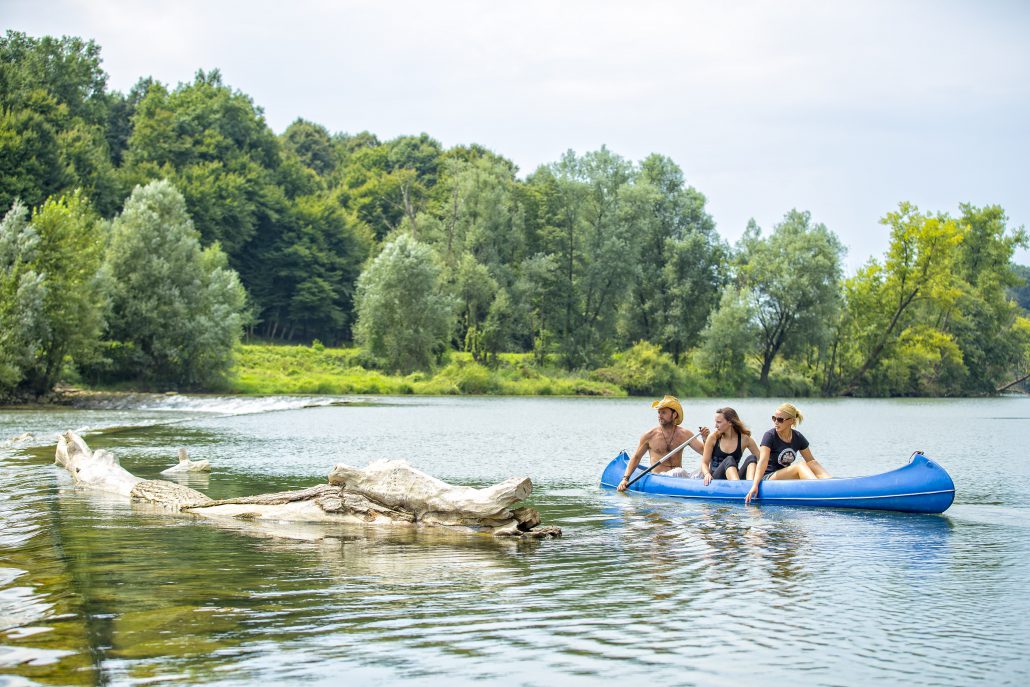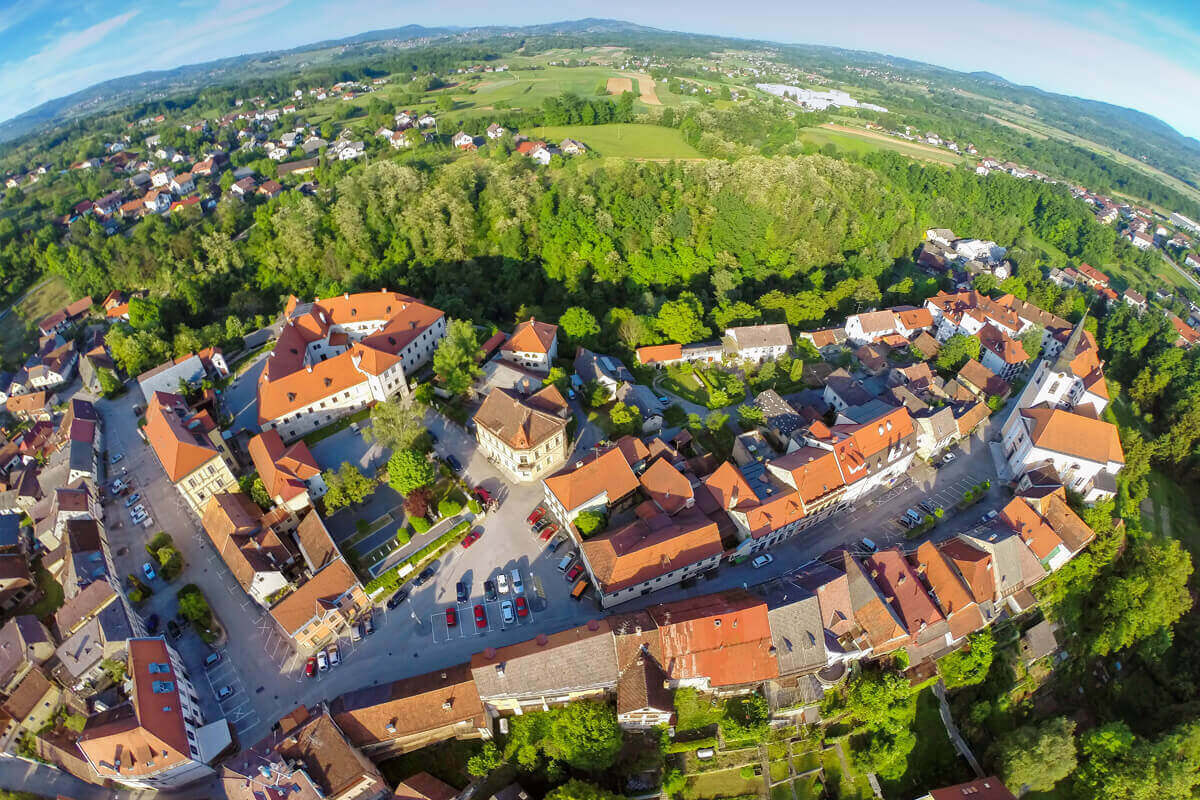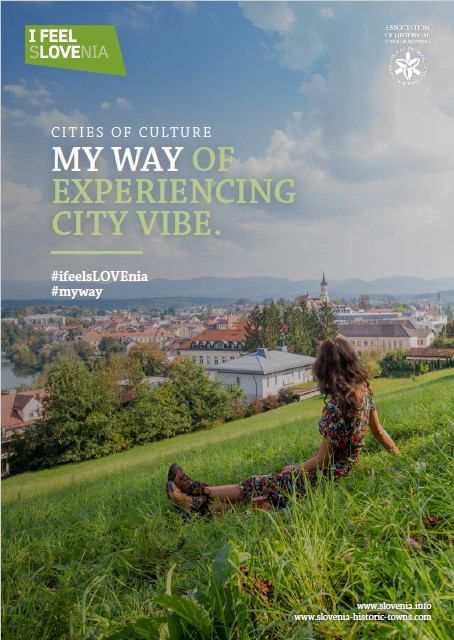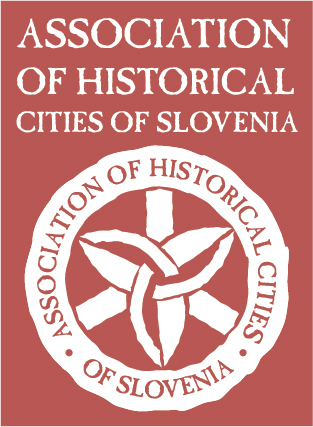Different stories of Bela krajina
Get to know the locals and their legends. Test yourself in the town challenges. Go to a place where they fetched water from. Follow the paths of various creators and - fire fighters.
Start with refreshments and - instructions
If you come to Metlika when the House of Delicacies of Bela krajina (1) is open, you can enrich your wandering among the town’s sights with a special adventure. Arm yourself with instructions in the house, where various delicacies await you. At the end of the tour come and collect your prize. If that does not appeal to you, make your walk more pleasant by conversing with hospitable locals.
Recommended time for a stop: 10 minutes.
Welcome among the legends of Metlika
As you exit the House of Delicacies, your gaze stops at the Town Hall (2). Get closer to see the Metlika coat-of-arms on the building. It is associated with a dark legend known to every local. Take a challenge: stop a passer-by and ask if he or she knows this urban legend.
Recommended time for a stop: 3 minutes.
Stories of the black cross
Continue your walk from the Town Hall to the Church of St. Nicholas (3), first mentioned as early as 1334. Here, an important chaplain served for two years before going to America to spread the Christian faith among the Indians. Who was it? Find his memorial plaque in the church. As you exit the church, look at the black cross above the front door. It takes you back to the 13th century. Continue to the Commenda House (4), built by the Crusaders known for their white robes with black crosses. In the 12th and 13th centuries, during the religious wars, this knightly order from German lands also reached the Slovenian territories. Take a look at its coat-of-arms. What would you draw for yourself?
Recommended time for a stop: 10 minutes.
The creativity of people and nature
At this point, turn right into the first street on your right (Na Obrh) with Gangl’s birth house (5). Here, the sculptor Alojz Gangl and his nephew, the writer and Sokol organizer Engelbert Gangl were born. From here, go down into the valley to the Obrh educational trail (6). Look closely at whose sharp teeth have imprinted their marks on the trees here. Combine creative inspirations of both the town and nature and treat yourself to a stop at didactic play equipment. You are invited, among other things, to create your coat-of-arms. Walk for just a few minutes more and you will reach the source of the Obrh stream (7), where women once washed clothes with home-made soap, beech ash and boiled water heated in a cauldron. Right next to the source of the stream, a washing bucket is also prepared for you.
A Tip: If you have accepted the challenge and equipped yourself with instructions for the Metlika adventure at the beginning of the journey, now is the time to use a piece of fabric and soap from your backpack.
Recommended time for stops: 30 minutes.
Get inspired by folklore
After a short walk up the hill, you arrive at Partizanski trg square. Here, a house with the blue and green windows catches the eye. This is the birthplace of Ivan Navratil (8), an ethnographer, who was the first to systematically document folk customs. The people of Bela krajina are very proud of their folklore tradition, typical white linen costumes and the Metlika folklore group (9).
A Tip: The Metlika adventure includes a white napkin – peča (a scarf that is worn by married women as a sign that they had already been given away) and instructions how to properly bind it. It is not easy. Try it. You can also ask the locals for help.
Recommended time for a stop: 5 minutes.
Among the first fire fighters
Trg svobode square is home to Branko Božič’s Slovenian Fire Museum (10). Why is the museum that represents the exceptional firefighting heritage of Slovenia right here? The locals like to joke that it is because the Turks burnt down Metlika seventeen times. The first fire brigade in Slovenia was established in Metlika in 1869.
A Tip: Spice up your visit with a ‘firemen’s photo ‘and share it with your friends. Use hashtags #belakrajina #metlika #sloveniahistorictowns on social networks.
Recommended time for viewing: 30 min.
To castle of different experiences
Just a stone’s throw away is Metlika Castle (12), the courtyard of which is the most beautiful venue for town events. The castle was first mentioned in 1456. Today, it houses the Bela krajina Museum (13) and Vinoteka Šturm wine shop (14). You will also find the Tourist Information Centre here. At the entrance to the castle are busts of people who contributed to the recognisability of Bela krajina. Among them is also the statue of the Slovenian poet Oton Župančič (15).
A gallery of an exceptional couple
Leave the squares of Metlika and descend to the main road that leads through the town – Cesta bratstva in enotnosti road. Turn left and you will soon reach the Kambič Gallery (16). The collection of works of art by Slovenian artists also includes works by the impressionist Rihard Jakopič and as many as 12 works by Zoran Mušič, one of the most recognizable Slovenian painters in the world. The gallery, including the house and the art collection, were donated to the town by Vinko Kambič, an internationally renowned doctor, and his wife Vilma Bukovec Kambič, an opera singer. Free admission.
A Tip: Dare to show your singing enthusiasm. In honour of the prima donna Vilma Bukovec Kambič, try and sing an opera aria in the middle of Metlika.
Recommended time for a stop: 20 minutes.
Mrs. Juričina’s thatched roof
As you cross the road, look to your left at the church bell tower and the houses above the former Bojica stream. A few meters further on, to your right you will notice the only house in Metlika covered with straw. This is the Bara Juričina House(17). It is worth a short stop because it is a typical example of the traditional Bela Krajina architecture. The story of its inhabitant is also worthy of special respect. Bara Juričina made a living by carrying water from the Obrh to the wealthy townspeople in Metlika. Think: Would you be able to do this? Several times a day?
After the stop, cross the main road again and return to the starting point (1) of your wandering by crossing the bridge over the dry riverbed of the Bojica
A Tip: If you have chosen instructions for the Metlika adventure at the beginning of the tour, a tasting of selected Bela Krajina wines is waiting for you in the House of Delicacies. The youngest will have locally produced juice.
Recommended time for a stop: 5 minutes.
Suggestions for a hike
To the Kolpa river?
The Kolpa River is known as the warmest and cleanest Slovenian river, which offers plenty of opportunities for sports activities on, along and in the river. Are you tempted by an adrenaline rafting descent? A quiet walk along its banks? The Kolpa invites you! Well-kept bike paths and footpaths are a great way to get to know both the river and the way of life along the Kolpa. The deep riverbed and playful waves are a rafting paradise. Clean water and abundance of fish are the reason why fishermen visit Kolpa. The steadier river part provides a first-class experience for canoeing, SUP and swimming enthusiasts. The calm and warm river reaches a temperature of 30 degrees in the lowlands, while the bubbling water on the waterfalls offers divine massage and relaxation. There are several campsites in the municipality of Metlika, in the lowland part of the river. Here, a solitary individual as well as the whole family finds rest and relaxation. Recreational athletes and adrenaline junkies will enjoy full experience here.

1. The house of delicacies of Bela krajina
The house in the old town of Metlika, which was once a shop, offers selected local products. You can choose from the best that the local winemakers, fruit growers, gardeners, beekeepers, herbalists and other producers of Bela krajina delicacies offer.
Mestni trg 7, T: 07 363 60 55
2. The town hall
The building from 1869 has a noticeable cast of the town’s coat-of-arms – a castle with two ravens – on the roof façade of the masonry towers. There has been an inbuilt memorial plaque in honour of the soldiers who fell during the First World War since 1928. During the Second World War, the town hall was the seat of the National Liberation Committee.
Mestni trg 24
3. The church of st. Nicholas
The church was first mentioned in 1334. After the fires during the Turkish invasions in the 16th century, a new one was built. In 1759, after a fire at the beginning of the 18th century, a Baroque church was built on its remains. It was modelled after the cruciform church in Ljubljana. The Way of the Cross in the church is the work of Josip Egartner. It was paid for and hung by Frederick Irenej Baraga, who later became a missionary and a bishop among the American Indians. He served as chaplain in Metlika in the years 1828 – 1830.
Mestni trg 14
4. The Commenda house
Strictly military and hierarchically organized crusaders based in East Prussia came to Bela krajina soon after their establishment. The Commenda of the Teutonic Knights in Metlika is mentioned in 1310. 40 years later, the order’s hospice is also mentioned. The crusaders, who were first soldiers, were later priests and caregivers of the sick. The Metlika Commenda and the adjacent Provost’s House form a unified building structure. They were used as infirmary before the Second World War. Today, the retirement home is located on the premises.
Mestni trg 16
5. The birthplace of Alojz and Engelbert Gangl
Alojz Gangl (1859 – 1935) created the first Slovenian statue of national importance during his studies in Vienna. He made a bronze statue of Valentin Vodnik, an important Slovene enlightener. His statue was placed in front of the then Ljubljana lyceum in 1888. His expressionist statue of Christ – the lone traveller, stands in front of the cemetery in Metlika. His nephew, Engelbert Gangl (1873 – 1950), was a writer, teacher and Sokol organizer. They were both born in the same house in Metlika.
Mestni trg 19
6. The Obrh educational trail
The educational path along the Obrh, a left tributary of the Kolpa River, presents the rich ethnological and environmental history of the stream, which springs under the walls of the old town of Metlika.
The path to the source of drinking water is 200 meters long. The information boards along the way present underground and above-ground system of the Obrh. You can rest on the benches, while younger visitors have fun and play.
7. The spring of the Obrh
The spring of the Obrh, from which drinking water was once carried into the town, was an important meeting point where women gathered for washing. The laundry was washed by placing old shards on the bottom of a wooden bucket. They were covered with a large sheet and stacked pieces of laundry to the top of the bucket. Then they arranged beech ash, bound in linen bags, onto the laundry. The bucket had a hole on the side that was plugged with a stick. Water boiled in a cauldron was poured over the laundry in the bucket and left to cool down. This was repeated until the laundry was washed. The ‘laundry spot’ is now arranged as an adventure scene with a bucket.
8. The birthplace of Anton and Ivan Navratil
Ivan Navratil (1825 – 1896) was a Slovene linguist, ethnographer and editor who founded the first Slovene youth newspaper – the weekly called Vedež. He collected linguistic and ethnological materials from Bela krajina and compared and explained his findings with the phenomena from elsewhere. He also worked hard all the time to establish the Slovene standard language. Anton Navratil (1832 – 1897) was the founder of the reading society and its president for 20 years. They were both born in the same house in Metlika.
Partizanski trg 30
9. The Ivan Navratil Folkore group from Metlika
In Metlika, young people once danced and sang on Vuzem (Easter) Monday as was the Metlika custom. Ivan Navratil wrote about this in 1849. In 1936, the first folklore group was founded in Metlika. This heritage has been carried on since 1976 by MFS Ivan Navratil folklore group, which cultivates dances and songs of the entire Bela krajina area. The group has toured in almost all European countries. Under the auspices of the group, there is a tamburitza ensemble that accompanies the dancers at performances.
10. Branko Božič’s Slovenian fire museum
The museum, founded in 1969, on the centennial of organized firefighting in Slovenia with preserved uniforms, helmets, axes and other firefighting gear, represents the time before the First World War. The museum, named after the long standing President of the Firefighting Association of Slovenia, exhibits an old firefighting technique on four-wheeled carts. In the pavilion adjacent to the building, numerous portable fire sprinklers are exhibited. The oldest dates from 1836.
Trg svobode 5, T: 07 30 58 697
11. Metlika castle
Metlika Castle stands on the highest point of the natural promontory between the Obrh and the Bojica streams. The medieval documents first mention it in 1338, but its design is probably much older. Inside the castle building is a spacious courtyard surrounded by arcades. The castle played an important defensive role during the Turkish invasions in the 15th and 16th centuries. After the fires of 1705 and 1790, the former fortress got the appearance of a town residence.
Trg svobode 4
12. The Bela krajina museum
The permanent exhibition in Metlika Castle tells the story of Bela Krajina from prehistory to the mid-20th century. It includes the archaeological collection of the finds from the ancient times, the cultural and historical collection, showing the time since the occurrence of towns in the 14th century to the times of the Illyrian Provinces, and the ethnological collections about “Beli Kranjci”, who were known for their white apparels. The collection of contemporary history recalls the most important events in the first half of the 20th century. Here, the time period of the WWII stands out, when there was a unique free partisan territory between the Kolpa and the Gorjanci hills.
Metlika Castle, Trg svobode 4, T: 07 306 33 70
13. Vinoteka Šturm wine shop
In the wine shop on the ground floor of Metlika Castle you can taste a variety of wines: white, red or rosé, youthful or mature, dry or sweet, calm or sparkling. Grapes for their excellent wines grow on a family estate in nearby Vidošiči, just a few kilometres from the centre of Metlika.
Castle cellar, Trg svobode 4, T: 031 632 470
14. The statue of the poet Oton Župančič
Oton Župančič (1878 – 1949) was born in the Bela Krajina village of Vinica. During his lifetime, he enjoyed the reputation of the greatest living Slovenian poet. He was the president of the Slovenian Writers’ Association, the first president of the Slovenian PEN and one of the first members of the Slovenian Academy of Sciences and Arts. His bust was erected in 1978 by the Bela Krajina Museum Society, and was made by the academic sculptor Zdenko Kalin. In Vinica, you can see the museum collection about the Bela Krajina master of words in his birth house.
15. The Kambič gallery
The collection of national importance, which was donated to the town by the Kambič couple in 2003, includes cultural and historical objects (paintings on glass, furniture, clocks, lamps, arts and crafts products) and artworks of various Slovenian artists: from the generation of realists and impressionists to the now living artists. The house also includes a collection dedicated to the donors – the doctor Vinko Kambič and the opera singer Vilma Bukovec Kambič.
Cesta bratstva in enotnosti 51, T: 07 305 83 32
The Bara Juričina house
The house, inscribed in the Franciscan land registry in 1824, is an important cultural monument. The house with an L-shaped floor plan is one of the 100 most beautiful farmhouses in Slovenia. With its originality, it still shows the living conditions and social dimensions of the former architecture within the urban area.
Frelihova ulica 4
- 11. The house of delicacies of Bela krajina
- 22. The town hall
- 33. The church of st. Nicholas
- 44. The Commenda house
- 55. The birthplace of Alojz and Engelbert Gangl
- 66. The Obrh educational trail
- 77. The spring of the Obrh
- 88. The birthplace of Anton and Ivan Navratil
- 99. The Ivan Navratil Folkore group from Metlika
- 1010. Branko Božič’s Slovenian fire museum
- 1111. Metlika castle
- 1212. The Bela krajina museum
- 1313. Vinoteka Šturm wine shop
- 1414. The statue of the poet Oton Župančič
- 1515. The Kambič gallery
- 16The Bara Juričina house





